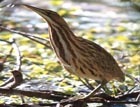Bitterns found nesting in the Fens
Four nests of bitterns have been discovered nesting in the new East Anglian Fens


Numbers of nesting bitterns are at their highest since records began in 1990, with 51 male bitterns recorded across 33 sites in England, according to a survey conducted by the RSPB. Moreover, bitterns have been found nesting in the East Anglian fens for the first time since before the Second World War.
Having been extinct in Britain from 1886 to 1911, bittern numbers reached an all-time low in 1997 with just 11 males recorded. By 2004 this had recovered to 55 males, which stands as the record for recent times. This figure dropped back to 44 last year. Bitterns remain difficult to monitor, however, as they live in reedbeds and can be extremely difficult to spot.
East Anglia was the bittern's original habitat, and the reedbeds where they have been discovered were developed specially by a private landowner from Grade 1 arable land. The 150-acre site in Cambridgeshire was converted to wetland with the help of the RSPB.
Dr Tom Tew, Natural England's Chief Scientist, says 'Natural England and its partners are committed to creating new wetlands and the bittern's success at newly created reedbeds is an example of how effective we can be.'
Sign up for the Country Life Newsletter
Exquisite houses, the beauty of Nature, and how to get the most from your life, straight to your inbox.
Country Life is unlike any other magazine: the only glossy weekly on the newsstand and the only magazine that has been guest-edited by HRH The King not once, but twice. It is a celebration of modern rural life and all its diverse joys and pleasures — that was first published in Queen Victoria's Diamond Jubilee year. Our eclectic mixture of witty and informative content — from the most up-to-date property news and commentary and a coveted glimpse inside some of the UK's best houses and gardens, to gardening, the arts and interior design, written by experts in their field — still cannot be found in print or online, anywhere else.
-
 'The watch is Head Boy of men’s accessorising': Ginnie Chadwyck-Healey and Tom Chamberlin's Summer Season style secrets
'The watch is Head Boy of men’s accessorising': Ginnie Chadwyck-Healey and Tom Chamberlin's Summer Season style secretsWhen it comes to dressing for the Season, accessories will transform an outfit. Ginnie Chadwyck-Healey and Tom Chamberlin, both stylish summer-party veterans, offer some sage advice.
-
 Lewis Hamilton, Claude Monet and the Four Horsemen of the Apocalypse: Country Life Quiz of the Day, April 29, 2025
Lewis Hamilton, Claude Monet and the Four Horsemen of the Apocalypse: Country Life Quiz of the Day, April 29, 2025Tuesday's Quiz of the Day looks back at Lewis Hamilton's first win and ponders on the meaning of greige.